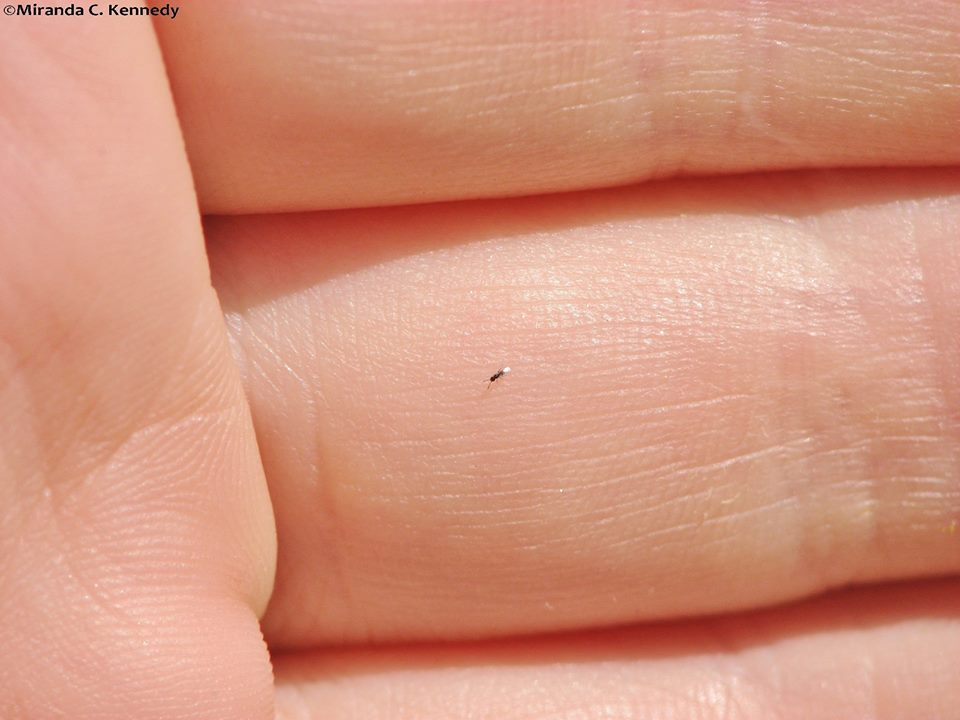-
Finches Eat Sunflower Leaves
Are your sunflowers being stripped? Are the leaves acquiring non-snail-like holes and then disappearing altogether? You may be feeding the birds, but not with the seeds!
Lesser goldfinches apparently are nuts over sunflower leaves. They will tear little bits of the leaves off and injest them, and within a day or so there will be nothing but a stem and a flower.

If your goal is to feed the birds, then this is okay. If you have bird problems on your vegetables such as peppers, then you may want to plant sunflowers off to the side to distract them.

Why do they eat sunflower leaves? They must like a little salad with their seeds, and sunflowers are particularly yummy for them. In searching the Internet for suggestions as to why they like sunflower leaves so much, there were many postings about the incidents, and yet most respondents insisted that the birds were after bugs on the leaves, or that snails came in the night and ate the leaves!
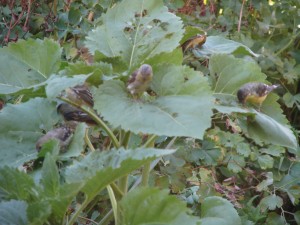
This occurrence seems to happen mostly in California, and other than bird nets (which one person said that the lesser goldfinches chewed through!) or planting sunflowers thickly (one for them, one for you), you may as well just enjoy the show. Ours come up from dropped or buried birdseed, and when the plants are growing their flowers, suddenly they are beset by birds who skeletonize the plant. We’re okay with that; it saves a little cost on the very expensive Niger thistle seed! (Oh, and by the way, Niger thistle isn’t thistle seed at all).
-
Hiking Santa Ysabel Open Space Preserve

Ancient god face in wood Today my daughter and my hiking buddy Alex spent almost five hours hiking a seven-mile trail in the stunning Santa Ysabel Preserve. Alex and I hiked the Kanaka Loop trail before, taking less time, but today we stopped often for photographs of the abundant birds, insects, plants and incredible views.

A small pine in the shadow of a fallen giant Managed by the County of San Diego Parks Dept., this open space preserve has two entrances. The West Loop Trail, which is short and mostly easy, is off of Highway 79, and the main entrance and staging area is off of Farmer Road past Julian (http://www.sdcounty.ca.gov/parks/openspace/Santa_Ysabel.html ) . Each entrance offers loop trails, and are connected by a portion of the Coast to Crest Trail.
This preserve is the home of ancient oak riparian woodlands,

Out of a storybook 200-year-old sycamore groves,
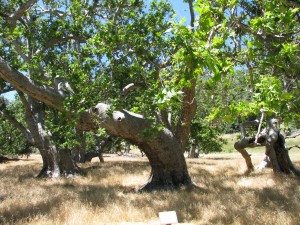
Two-hundred year-old sycamores stunning views of the mountains and hills west, with a glimpse of Palomar Observatory in the far distance

The View towards Palomar Observatory and equally serene pastoral landscapes of mountain homes, apple orchards and rolling hills in the southeast.
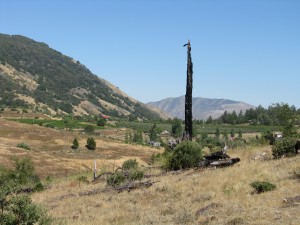
A beautiful valley of apple groves At this time of year the grasslands are pale gold, and ripples travel for acres in the very welcome warm breeze that kept this July day from being overwhelmingly hot.
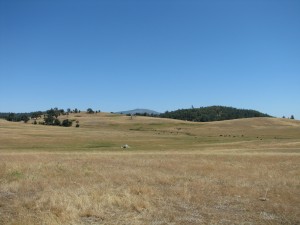
Rolling grasslands A new experience for us was to walk miles of trail while disturbing thousands of grasshoppers that flung themselves out of the way or took wing to avoid us. It was like setting popcorn off as we walked, trying to not tread on any but also being hit by some misdirected fellows. One took a ride on my pants for awhile until he began to investigate my pants pocket and I had to give him a boost to freedom.
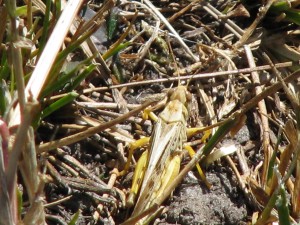
Grasshoppers It was a glorious day for birding; some of the birds we saw were flocks of Western bluebirds, kingbirds, a lark sparrow, a Lazuli bunting, ravens, chipping sparrows, goldfinches, bushtits, both spotted and California towhees, acorn and Nuttall’s woodpeckers, a Northern flicker, a Cooper’s hawk, an American kestrel, Western meadowlarks, brown-headed cowbirds, cliff swallows, Steller and scrub jays, Mountain chickadees, and many turkey families, their brood half-grown and comically awkward. We saw bright red Large Milkweed Beetles on blooming Indian milkweed, a late blooming Summer lupine, and did I mention grasshoppers? Thousands of grasshoppers. Almost the entire hike. A pair of ravens sat in the tall grass to the side of the trail with their beaks open, catching them as they leaped, as did Western bluebirds and others.
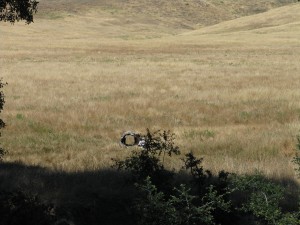
A hollow stump that looks like a TV set The Preserve is also home to cattle, and groups of the little ladies and their offspring dotted the landscape. Many bad cow jokes ensued (they’re in a bad MOOd; you can’t HIDE from them, they are UTTERLY charming, we’ve got to HOOF it past them, let’s MOOve it along… well, you get the picture), and although they watched us warily, they gave us no problem and we spoke to them soothingly as we passed by.
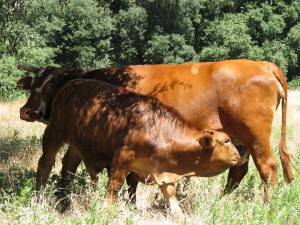
Lunch The Kanaka Loop Trail is easy up to the streambed crossing,

Good run-off for July then it goes uphill in areas which are bare due to elevation and past fires, so there is little cover. Many pines have sprouted up and their fragrance in the heat is intoxicating. However twice during the trail up through the trees we smelled greasy french-fries, and have no idea what plant or combination of flowers created that scent. It is an exceptionally beautiful trail and not difficult for the average hiker, but be sure to take a hat and lots of water, and a good attitude towards cows!
-
The Importance of Leaving a Mess

Animal tunnels through a brush pile A clean yard is usually a pleasing sight. Picking up loose boards, plywood, sticks and logs keeps people from tripping, is encouraged by the fire department to reduce fuel for fires, and makes for more room to walk. Also, things live under debris and we’ve always been told to not poke our fingers into dark places (excellent advice! If a giant stuck his huge finger into our bedroom window we’d try to hurt it to make it go away, too!), and by eliminating so-called debris we reduce the chance of bites by snakes, spiders, or whatever bitey things may be living in your part of the world.
However, by reducing the debris, we also reduce habitat. Those bitey creatures need a place to live, as do the non-bitey creatures we are also displacing by removing wood. All these creatures are part of the intensely woven food web that keeps our planet populated and working. I cannot disagree about making your yard safe for children and pets, but if you have a space, make an area for habitat, too. Rope off a corner of your yard and tell your children and pets not to go into there, and leave bundles of sticks, pieces of plywood, old logs, piles of leaves, etc. in that corner. This is a home for the wild things, and your children can understand, observe and respect the fact that the world should not be made clean for them. Teach your children not to hunt and catch wild things, not to tear apart nests and destroy habitat. Observe and wonder instead.
In my yard, especially since I’ve had some sheds removed (in which racoons, wasps and possums raised families… I’m hoping to make a new place for them), I have stacks of plywood and old buidling materials which are good for recycling back into projects around my house. A junkheap, yes; a goldmine, yep. Under these stacks I have found such wonderful creatures that I didn’t even know came into my yard (perhaps they didn’t until the wood was left out).
The most exciting creature was a female Western pond turtle.

Female Western Pond Turtle In Washington, the Western pond turtles are endangered, and they are considered threatened in Oregon and are becoming rare in California and Baja California. Besides loss of habitat and an increase in pollution, one of the major factors in our native turtle’s slow demise is the release of non-native aggressive species such as the red-eared slider turtles. Red-eared sliders are America’s favorite pet turtle although they are native to the Southern United States. Due to releases they are everywhere. DO NOT RELEASE YOUR PET INTO THE WILD! As much harm has been done by and to domestic animals and wild animals by the releasing of pets as by habitat loss. A number of years ago there was a salmonella scare allegedly traced to pet turtles. The public’s response was to dump their children’s turtles in any waterway close by. Red-eared sliders have a distinctive red line by their eyes, and are named sliders because that family of semi-aquatic turtle can slide into the water quickly. They are omnivorous, aggressive, adaptable and become large. They eat anything that they can fit into their mouths, including the less aggressive smaller Western pond turtles.

Females have flat plasterons; notice her left stumpy leg. Finding a female Western pond turtle in the yard was fantastic, and I can only surmise that she had made her way up from the shallow streambed below the property to hopefully lay eggs. I haven’t found signs of a disturbed area yet where she may have layed, but am keeping the whole area protected just in case.

Long tails She is missing one front foot, probably bitten off while a youngster when something was trying to eat her. Before we knew she was a she, we thought of giving him a piratey name due to the missing foot and her semi-aquatic nature. Captain Blood was too fierce, but the author of that and other swashbuckling tales which had been made into movies is Raphael Sabatini. Now that is a terrific name. Go ahead and say it to yourself. See? So he became Raphael Sabatini until we checked her plasteron (the underside of her shell) and realized that it was flat not concave, which meant that she was a female. Males need concave plasterons so that when they are, um, amorous, they don’t fall off so easily. So she became Mrs. Sabatini. Long story… sorry. Nothing simple in my life. Anyway, we checked out Mrs. Sabatini’s health, and then released her into our small upper pond, which has an excess of mosquito fish and bugs, so that she wouldn’t be hurt with all the work that is being done down where she was found. We haven’t seen her since, so hopefully she is healthy and happy.

Good-bye Mrs. Sabatini! Under another piece of plywood I’ve found blue-tailed skinks (I couldn’t take a photo because they move too quickly), California Slender Salamanders,

California Slender Salamander gopher snakes, king snakes,

California Kingsnake and Pacific chorus frogs.
In a brush pile there are many birds hopping through, especially California towhees, Western fence lizards, alligator lizards, tree rats, mice and many other creatures.
In the ground are insects that you’d never expect. For instance while weeding one of my heirloom bulb beds I disturbed this huge caterpiller that had a horn tail.

White-lined Sphinx Moth Caterpiller The only horn tails that I’m familiar with are the tomato hornworms, but this guy was far away from my veggie patch, and instead of stripes had spots. We looked him up, and he is the caterpiller form of the White-Lined Sphinx Moth, also known as the hummingbird moth because of the way it hovers in front of night-blooming flowers to drink nectar. It is one of the important nighttime pollinators which few ever see. We put him back and left some weeds in for him.
Of course mason bees, among other pollinators, use holes in wood in which to nest. Some bumblebees nest in abandoned gopher holes, and they are the natural pollinators of many native North American plants such as blueberries (honeybees were imported from Europe with white settlers; until then native plants developed their flowers to attract and accomidate bumblebees, wasps, and hundreds of other native insects.)
All around my property there are logs and brush piles, and plywood layed down to choke out weeds in my veggie garden. Underneath there is a world of habitat. Isolated refuges for animals and insects who desperately need places to feel safe. So go ahead, throw down some mulch, some logs, a pile of sticks or some plywood. Know that you are doing the Earth a favor.
-
When Chickens Fly
My seven chickens are quite the young women now. They really should be out in a pen, not still in a Rubbermaid container in the side room, but tractor work will be started this week and I don’t want to horrify them with large machinery. The big girls have begun to squat on the floor like broody hens. Most of their feathers are in and they look very sleek and lovely. The Americaunas, who are almost two week older than the others, are much larger and also much shyer. They are usually at the bottom of the pile when I go in to change their water. Why is it that I’ve held them, fed, watered and cleaned them, crooned to them, and every time I put my hand in there they start screaming and flying around as if I’m going to murder them? I’ve explained my vegetarianism to them, after all!

Lovely Ladies Then there are the two smaller girls, the Barred Rocks. These girls have attitude. They were in a large cardboard box for awhile, but the larger of the two kept jumping up and out. Last week I found that they were in the same container as the larger girls! Apparently they both got out of their own box, had a time pooing on the floor, then went exploring into the big girl’s domain. The Barred Rocks (BRs) were in one corner, and all five of the big girls were dogpiled in the far corner. They were all frightened of each other! (Yes, the term chicken comes to mind here.) I left them for the night thinking that maybe they’d settle in together (no pecking), but heard intermittant squawks. Apparently the Silver Wyandotte would be brave enough to verture over and scare the BRs, then the larger of the BRs would venture over and scare the others. Geez. So I pulled out an old birdcage and put the BRs in it. They like it just fine, and are enjoying the wooden perches. Of course, teaching chickens to perch in trees is not a good idea, but I have experience with this phenomena.

Barred Rock Songbirds About fifteen years ago, me and my young children were living in a house in Vista along a busy steep road. Across that road was a fenced property with avocado trees and a couple of loud Rottweilers. On the corner of my yard was a tall pine tree that stretched past the convergence of telephone wires.
I had the opportunity to aquire some mature hens from my boss who couldn’t keep them any longer. One in particular was a Barred Rock with an attitude. We were novices at chickens, just claiming cats, dogs, fish and tortoises at the moment. The first night the chickens spent in the garage. Chickens after dark are like moaning footballs. Like bees, they don’t fly after the sun falls, and those who would scream and behave as if they were about to be axe-murdered upon your approach in the light, would in the evening suffer you to pick them up and tote them around like inanimate objects. Inanimate except for the low crooning moans of great distress and sadness that chickens use as lullabys.
I built a very large, and in my opinion, handsome cage for them on wheels (a chicken tractor and I didn’t even know it!), and there they lived. We allowed them to roam during the day when we were home. Then we found that one of the Barred Rocks, and I’ll give her name to you now as DC although that sobriquet was bestowed later, enjoyed flying up to the lowest limbs of the great pine tree. I’d never heard of chickens flying. There are, thankfully, no chicken migrations darkening the sky across the Southwest. If you haven’t seen a chicken for awhile, take a gander at one (oops, wrong fowl) and notice how round and large they are. They are not sleek, flying birds. The BRs, mostly black with white dabblings all over them, look especially rotund and solid, like cast iron. My children and I thought that DC aiming for the heights was, at first, funny.
Then came the day that I went outside to find that DC had set and acquired goals for herself, and had fluttered branch by branch up the pine tree until she was very high up indeed. We tried to lure her down with food and endearments. My son attempted to climb up after her. DC, the most ornery of birds, instead of retreating into the waiting arms of my son, decided to fly. Her first flight was a brief one, more of a fluttering really, to the telephone wires that lined the busy street. There she sat, proudly swaying back and forth on the slender line. If you haven’t seen a chicken on a telephone wire, you really can’t imagine what it looks like. It isn’t like seeing a hawk or another large bird, because they are shaped the way they should be. A chicken, as I’ve said, is like a dark super-sized soccer ball balanced on a wire as if ready to drop any moment. They shouldn’t be that high. I think only seeing an ostrich on a telephone wire would look as strange. The vehicles that came speeding down that hill slowed and made careful detour around the area where she might land if indeed she did drop and shatter their windshields. DC appeared to be about to break her neck, and at this point I was saddened at the thought that it would be her own machinations and not my two hands that would do the act.
My thought now was to get her to fly, or rather drop, back into the fenced area of my property. I don’t remember what time of day it was, but I was dressed in my Park Ranger uniform and badge. There I was, on the far side of the two-laned road in uniform, dodging and directing and apologizing to drivers, an armful of pine cones at the ready, chucking them as high as I could at DC. I am a poor pitcher and none of them came close. However the shouting, the chucking, the passing vehicles and the breeze all made DC come to the decision that she was, indeed, a flying chicken. With grace she launched herself. Chickens don’t fly, but they will, if the wind is willing, glide. She passed unsteadily over the road, causing the driver of a pickup truck to swerve as he caught sight of the immense black object bearing down on his windshield. She just hit managed the top rail of the neighbor’s chainlink fence before teetering over and falling into their yard of avocados.
Dropping my armful of pinecones, saying unpleasant things under my breath, I went to knock at the door of the house who now had a new kind of bird in their yard. No one was home. I’d never met these people, and had only come away with a feeling of slight hostility from them. I went around to the gate in their chainlink fence and the lock was on it but unlatched. Closing the gate behind me I ducked under and around the variety of fruit trees, calling for my lost pet, hoping that the inhabitants of the house were not just lunching on the back porch with their rifles handy. I caught sight of DC, who looked no worse for wear but a little flustered by her adventures and in no mood to suddenly become docile and walk over to me. At the same time that I caught sight of her, I stepped in a pile of poo. A very large pile of poo. That’s when I remembered the Rottweilers.
I froze, listening. I hadn’t heard any barking, not even when I knocked at the front door. That could mean that the huge unfriendly dogs were on the back porch with their huge, unfriendly owners, and all of them had rifles. And as DC headed around the back corner of the house, I thought I’d pause and see what happened before I lost my direct pathway to the side gate.
After no explosions of ammunition or feathers occurred, I went after her. Bent over to avoid branches, hissing so as not to draw attention to myself, chasing her around in circles because chickens are the most uncooperative of animals, I finally cornered her. I threw a stick so that it landed behind her, and scared her enough to run towards me. I grabbed. She screamed and fussed as I ran with her tucked under my arm, not unlike a football, back across the street to the safety of my own yard.
It was afterat we began to clip her wing feathers,, and it was then that she earned the name of DC, which stands for…. Damned Chicken.
-
Idyllwild Photos

Boulder-studded hills This last weekend’s retreat to Idyllwild became extra special with the advent of April snow. I started out from Fallbrook at two o’clock, following my GPS through our granite-studded hills and golden-flowered valleys. As I drove through the Anza plateau in the beautiful afternoon sunshine, I started seeing glimpses of my destination, which the forecasters indicated would be snowy.
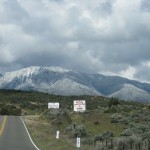
Snowy mountains Listening to my audiobook, occasionally holding up my camera to take photos through the windows (thank goodness for digital photos! All those random shots I can delete instead of pay to print and then throw out!) I reached the turn-off for Idyllwild and tall pines. I passed red gambrel barns, peaceful horse ranches, and then the first downy flakes started swirling around. I gave out a hoot to myself. Although I was born in New Jersey, my dear mother told my dear father that she never wanted to shovel snow again in her life, and they moved our family of five children West when I was five. I’ve visited snow a handful of times at Palomar when growing up, or with my children. Up until I drove through snow and ice in Ashland a couple of weekends ago on my trip to Oregon, I had little experience with it. Or did my Prius. On approaching town there was snow on the sides of the road, and it was swirling in large flakes.
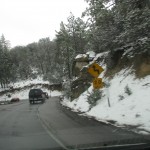
Snowy Road Traffic wisely crept along the icy road. Then suddenly, I was there.
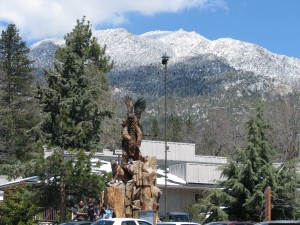
Totem (photo taken on the last day) I’d only been to Idyllwild once with my parents, some forty-some years ago. The only thing I remember was a large totem in the main square. I was startled to see it again as I arrived. It brought back good memories of my parents.
The snow had turned into round pellets, like those Styrafoam balls in Christmas scenes. I sat in my car outside the lodge for a few minutes absorbing the sight.
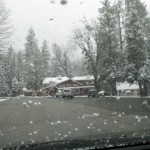
Round snow Oh, and it was cold. My spoiled San Diego self had to make some adjustments. Over the weekend I ended up wearing all the clothes I brought, mostly at the same time in various combinations starting with thermals. I thought I had mittens in my car but I didn’t, and I shouldn’t have had my haircut the day before, or thought to have brought a knit cap. But it was all okay. The lodge was comfortable, our hostesses treated us like royalty, I shared a room with a wonderful woman and we had a wall between us for privacy. The rooms were themed, and mine was, appropriately, The Library, and was decorated in old books and red plaid, which I love. It was perfect.

Plaid room After checking in and seeing my delightful room, I took my camera out onto the street and walked a circle around to town and back. I had to keep the camera nestled under my jacket to keep it from freezing. I wrapped my blue knit scarf that I bought when Miranda and I were freezing in the Orkney Islands when touring Pictish ruins around my head and neck like a babushka. I’m mature enough to sacrifice looks for warmth. ( At least, most of the time. I guess it depends on who is looking. Hmm, I’m still a girl at heart after all! ) The landscape was beautiful, like a picture postcard sprayed with glitter.
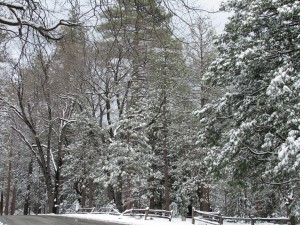
Snowy Trees The silence was so profound I could hear the snow fall. There was wildlife looking for food for their young. A mother Gray Squirrel was eating at a squirrel feeder. The bare spots on her tummy show that she is nursing young. I also saw Steller jays, robins, pine siskins, a flicker, crows, quail, goldfinches and acorn woodpeckers. There were bunny tracks in the snow.

Mother Squirrel That evening we communed by the fire in the lodge after a great meal of vegetarian vegetable soup and fresh bread. I enjoyed my cup of cocoa with peppermint Schnapps, but the caffeine made me sleep only three hours. I wasn’t alone with being tired; several other women had little or no sleep either. Saturday the sun was out and the snow began to melt, causing the streets to turn into running water.
Snow Flowers W e took a walk in the morning, ate macadamia nut pancakes, performed Tai-Chi, Zumba, aerobics, work at a barre, more walking, yoga and Pilates, then another walk into town for dinner. During dinner, it began to snow again, big, slushy wet snow that we hadn’t expected.
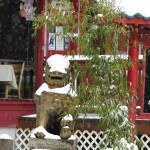
Hibernating Dragon It was dark when we finished eating, and we visited a couple of shops that stayed open for our group, then ventured through the very wet snowfall back to the lodge and warmth. It snowed all night again, to make our last morning one of magical landscapes. It was Sunday morning, the sky was blue with soft clouds, the quiet was profound and the snow sparkled as if someone had tossed around slivers of diamonds.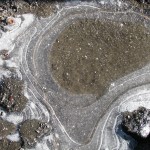
Ice A group of us took a silent walk through the snow and trees, not speaking, but pausing to perform simple yoga breathing and awakening stretches, welcoming the peace and freshness into ourselves and sending our thanks for the moment out to the universe.
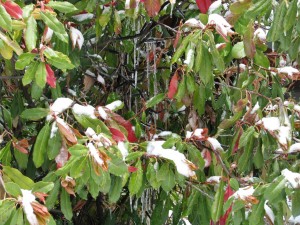
Icicles in Bush This exercise enervated me more than any other during the weekend; I only regret that not all of the women shared it with us. (After little sleep on the first night and a series of vigorous workouts through the day, along with all the energy spent shivering, several slept in.) One of the phenomenas of the morning was the rising sun catchingthe snow as it melted from the trees, highlighting the drops as if it were handfuls of glitter. I took many photos of it, trying to capture the spectacular sight, but none of them do it justice. If you look carefully at the photo, you can kind of see what I’m talking about.

Shimmering snowmelt After our wonderful breakfast (pecan maple pancakes!) we headed off down the mountain in glorious weather. I took a last explore through the town, finding a shop that made its own candles, some scented Idyllwild Cabin, and Campfire Smoke, and Citrus Champagne… and they really smelled like their names! I bought some Christmas gifts (beat the crowd! It was snowy outside after all!) and drove out of the snow to home.

- Easter Bunny Tracks
I’m posting more photos on my Facebook page if anyone is interested. The Spring Retreat turned out to be a Winter Wonderland, but I’m sure that it won’t throw the Easter Bunny off at all.
-
San Elijo Lagoon Hike
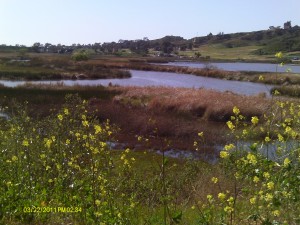
- San Elijo Lagoon
If you enjoy a hike along a flat trail with lots of nature to admire, you really should go to San Elijo Lagoon. Multiple times. That is because it has many different trails, most of which can be linked together for a long hike.
San Elijo Lagoon is protected by the San Elijo Lagoon Conservancy, the County of San Diego Parks Dept., and California Fish and Game ( http://www.sanelijo.org/welcome-san-elijo-lagoon-ecological-reserve). It is one of the largest wetlands in San Diego County, and the estuary is a wonderland for birders. The lagoon lies between Encinitas and Solana Beach, and occupies about 1,000 acres.
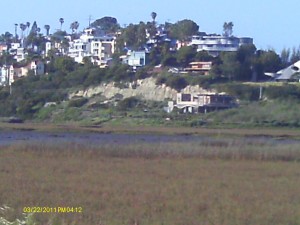
The Nature Center is run by the County and staffed by two rangers. In the photo at left it is the lowest building to the right of the cliffs. It is an fine example of a ‘green’ building, using solar, reclaimed water, a green roof and much more. Inside are very cool interactive computers and displays demonstrating how tides effect the estuary, the history of the area, and much more. Outside of the Nature Center is a boardwalk trail loop with benches and interpretive displays. During the change of tide there is a great opportunity to watch any number of seabirds fishing right next to the walkway. Watching the glorious sunset with the Coaster zooming past and cormorants fanning their wings on the telephone pole makes it easy to feel very, very happy about living in San Diego.

The Nature Center has a parking lot, and it is accessed from Manchester Ave. Visit the website for exact directions. The parking lot does have hours of closure, and this loop trail is independent from the other trails.
If you continue along Manchester you’ll see a sign for the Lagoon’s Dike Trail on the right. You have to park along Manchester Ave. Walking along the dike is one of the best ways to see dozens of seabirds, some in flocks of hundreds, very close-up. If it has been raining, you may want to check the condition of the dike because, as we found out, it can overflow.
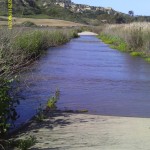
Once across you have the option of hiking West or East. If you opt for West, you eventually walk under I-5, which is an interesting experience in itself, then around through old Eucalyptus trees under the eroded cliffs overlooking the estuary. You have a choice of two trails which connect later, one takes the high road, and one takes the low road, so to speak.
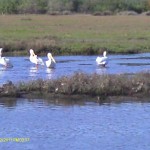
The lower one skirts the water and the higher one leads you through tall native plants. There are lots of flowers, birds, lizards, and interesting plants on either hike. At the end of the lower trail there are interpretive signs. The trail leads up to a trailhead off of North Rios Avenue, where there is street parking. You can continue West from there down to another walkway out into the wetlands for good bird viewing, and even further around the water and close to the train tracks past the water treatment plant (which is a little smelly) and out to where there are interpretive signs describing huge sewage tanks that had been at the site. That is as far as you can go, and you have to turn around and hike back.
Southeast of the Dike Trail are several miles of hiking that extend almost all the way to El Camino Real. There are several more trailheads to drive to and park.
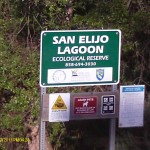
There are lots of joggers and hikers. The pathways are well maintained and I’ve rarely had to pick up any trash along the way. Along with many seabirds, songbirds and raptors you may see mule deer and find the tracks of nighttime visitors such as coyote and racoon.
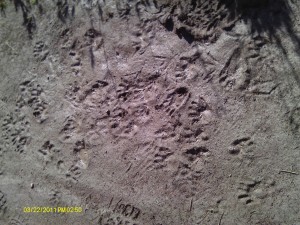
Although the hiking is along a flat area, there is a lot of it and the coastal sun is deceptively hot in that cooling breeze. Take lots of water, comfortable shoes (you can get them on shoe hero), a hat and sunscreen, and a jacket in case the famous low clouds and fog come blowing in.
This is a wonderful area for good exercise through several different plant communities with lots of good birding opportunities. You can’t do it all in one go, so plan for several trips, keeping an eye on the tide tables. Plan it around a good dinner at a coastal restaurant (such as Siamese Basil Thai restaurant in Encinitas… my favorite!) and an even beach stroll… sounds like a wonderful day to me!
-
From Willow, CA to Corvallis, OR. and back to Lodi, CA.

Snowy Mountains I’m at a hotel in Lodi, CA, which is a truck stop south of Sacramento. I’m halfway home, but, I get ahead of myself. Let me tell you about the second part of the trip to Corvallis…only two days ago!
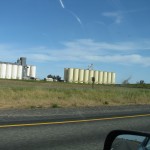
Grain silos After spending the night at Willow (North of where I am now), we headed up past San Francisco. We could see the city from the freeway. In the surrounding areas were miles of farmland and many immense grain silos.
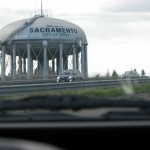
Sacramento; photo Miranda Kennedy Then the land became more beautiful, if less productive, as we passed Red Bluff, Redding, and the Mount Shasta area. Only we didn’t get to see Mount Shasta because it was covered with clouds. It was snowing.
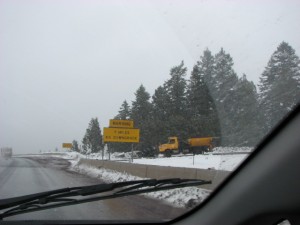
Snowplows (photo Miranda Kennedy) I haven’t driven in snow before, but it wasn’t blinding and the twisty mountain two-lane highway loaded with trucks wasn’t icy. The most trouble I had was avoiding being blinded by the spray from the semi’s wheels. We were surrounded by very beautiful pine forests loaded with snow. Then we hit the next mountain range of Ashland in Oregon and it began to snow in earnest. The road was very wet and ice was on the sides. Big fluffy flakes were circling around. We pulled over to a lodge to use the restroom and through the dining room windows the snow swirled as if made for a movie, and juncos were eating at bird feeders on the porch. We would have loved to have stayed to enjoy the sight, but my daughter and I were both afraid of the roads becoming more hazardous. I certainly didn’t have snow tires on the Prius. There were snow plows and whatever the red stuff that they use instead of salt on the roads.
Lodge We carefully edged back on the highway, and I now drove behind the trucks, keeping my wheels in their tracks figuring their weight and heat would have de-iced as they went. It was a bit tense heading down the hill. Why are there always people who have to speed, even in bad conditions? Once we were off the mountain the snow vanished and we had rain showers, especially once over the Oregon border where it rained almost solidly. After coming off that icy truck-filled narrow mountain path, rain wasn’t even an issue. We made it to Corvallis at about 3:30; a 1,014 mile drive from home.

Old House Corvallis tries hard to be a cute town, and it mostly succeeds. It has historical interest and lies in the beautiful Willamette Valley. Corvallis is on the agenda for those touring wineries, but more to our interest is that it is very attractive for migratory birds. There are preserves and parks all over with wonderful birding hides, walking paths and hiking.
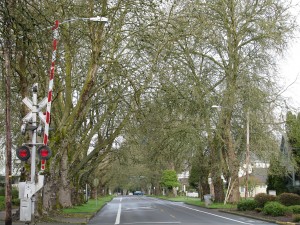
Tree-lined streets Since school started the next day (today), birding sadly wasn’t in the books for us this visit, even if the rain let up. However we did see magpies as we drove through Sacramento on the way up, which was a first on our lifetime birding lists for both of us. Corvallis is surrounded by farming areas, growing blueberries, grains, corn, and feed. This time of year there are thousands of bright yellow daffodils along the roads and in front of homes. Another welcome splash of color in the usually dark grey sky is from forsythia bushes which are in full gloriously yellow bloom. It rains a lot here. This school year, in fact, it stopped raining only to snow a bit, with occasional glimpses of blue sky as a tease between rain storms. Moss and lichens are very happy here, as are Canada geese. Berry bushes and wild apple and pear trees fill the preserves, but being wet and cold is the price for the fecundity of the landscape.
On the way back today I was anticipating heavier snow and ice storms, but to my delight the weather was clear and sunny the whole way.

Snowy mountains The mountains were covered with snow and beautiful. Mount Shasta’s volcanic shape draped in white suggested a more aggressive personality than the rounder surrounding mountains.

Mt. Shasta What beautiful rivers, pine forests and mountains. A couple of young elk were grazing by the side of the highway, and startled by a semi, ran back into the woods. I have a real love for this kind of scenery, perhaps born from my New Jersey birth, or cultivated from my first vacations with my parents and sister to Yosemite and Oregon, staying in rustic lodges, smelling pine resin and woodsmoke and listening to quiet.
Once I passed Red Bluff and Redding, then the scenery became more humanized and flat. Lots of buildings, old vehicles, signage… the poetry was gone from the view. And here I am in Lodi, CA, which may owe it’s interesting name to Chief Lodi. In fact, I compiled a list of the names of places I passed that were delightful to me: Tangent, Calpooia, Umpqua, Drain, Yoncalla, Edenbower, Riddle, Azalea, Jumpoff Joe Creek, Louse Creek, Merlin, Indian Mary Park, Valley of the Rogue State Park, Talent, Weed, Yreka, Hilt, Siskiyou, Jelly’s Ferry, and Yuba.
Tonight I dined at Rocky’s, which most certainly doesn’t have a veggie burger option, but does give you the ketchup right away with your food, knowing you’ll need it. Apparently I just missed the migration of thousands of starlings which cover the area through the winter, dining on the bugs in the surrounding fields. There are still hundreds left, and if you look closely you’ll see them on the sign in the following photo, taken from my motel window. To the lullaby of the traffic of Hwy 5, I bid you so-long. Tomorrow back to Fallbrook, and lots of walking!

Rocky's Cafe -
Chicken Tractors
To most people a chicken tractor sounds like some lame joke. Until fairly recently, I did too. However there are whole websites devoted to them. And as of this week, thanks to local carpenter Jay Tull, I am the proud owner of one!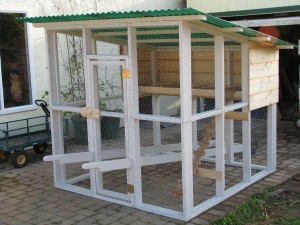
Chicken Tractor One of the fundamental ideas of permaculture is a holistic approach to land management and food supply. Keeping animals that produce food in a compassionate, healthy and useful manner is part of the puzzle. I am a lacto-ovo vegetarian and want dairy products that are produced using humane methods. Therefore, a chicken tractor! A chicken tractor is a movable coop with an unlined bottom. The chickens root around eating bugs, digging up weeds and pooing within the safety of their lovely tractor. You throw in some straw and they mix it into the soil and poo on that, too. In a few days or a week, that square of soil has been dug up, mulched and fertilized and it’s time to move on! So you move your tractor, chickens and all, to wherever you would like them to work next. Meanwhile you collect enriched eggs that have been laid by unstressed chickens who supplement their mash with bugs and greens out in the fresh air.
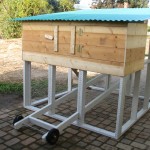
Back view If you have ever eaten eggs from backyard chickens, it may take a little getting used to. That is because the flavor is so interesting and fresh. Going back to supermarket eggs is like switching from chocolate to carob: as a satisfying substitute it just doesn’t fit the bill.
Chicken tractors come in all shapes and sizes. Check out these images: http://home.centurytel.net/thecitychicken/tractors.html. I must admit that my chicken tractor turned out heavier than I’d like, but it’s beautifully made and I’m very happy with it. We’ve joked about entering it in the Christmas parade. If you’re interested in chicken tractors (or chicken arks as they are also called), read Chicken Tractor: The Permaculture Guide to Happy Hens and Healthy Soil by Andy W. Lee. The San Diego County Library system has copies. (Did you know that you can order books from any County library online and it will be shipped to your local library? Visit https://dbpcosdcsgt.co.san-diego.ca.us/search).
This tractor is large enough for maybe four or five chickens at most, which would provide more than enough eggs for me. There are hundreds of web pages that focus just on chickens, and a handy chart that lists egg-laying characteristics can be found here http://www.mypetchicken.com/chicken-breeds/breed-list.aspx, as well as other places. Many birds lay brown eggs or bluish eggs; they don’t have any difference in any respect than white eggs other than shell color, so to pay more for brown eggs at the supermarket is criminal.
Oh, and of course, if there is a chicken tractor, there must be chicks:
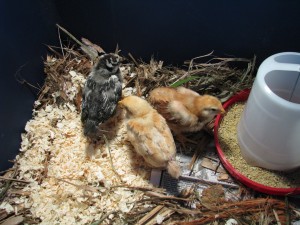
Two week old chicks These three ladies are two weeks old, and are from left to right a Silver Wyandotte, a Buff Orpington, and a Rhode Island Red. I want an Ameraucana (which is a hybrid of Aurucana, which lays the greenish and bluish eggs), and a Barred Rock, which is the traditional black and white chicken, but there were none to be had today as they are very popular. When some become available I’ll raise them seperately until they are mature and introduce them to these three so there is no bullying. Chickens lay eggs without a rooster, and do quite well without being harrassed and pecked at, too. My neighbors wouldn’t forgive a rooster, either. Right now my little chicks are too young for the Tractor, so they live in a Rubbermaid 50-gallon storage container with a 60-watt lamp on one side, water and mash in separate containers, newspapers and shredded bark underneath, and wire across the top because they are Chickens make wonderful pets and have a welcome spot in any permaculture system. Besides, they’re very cute.
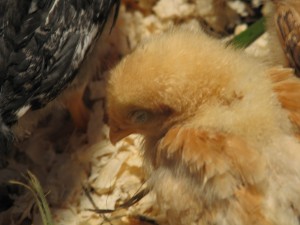
Sleepy chick (Photo credit: Miranda Kennedy)
- Birding, Gardening adventures, Heirloom Plants, Permaculture and Edible Forest Gardening Adventures, Photos
Brief Garden Updates

Palm Throne I spent the day making two birthday cakes for my two children, both of whom will be flying in from different directions tomorrow. Recipes will be the next thing I post! So for now, just a few garden updates. As you can see in the photo above, I have yet another palm throne, this one at the entrance to the garden. These are so fun. As the palms decompose, I can always plant in the seat!

Six loads of rock A total of six truckloads of rock have been delivered, and are piled in various areas on the property. At about 12 tons a load, that’s over 700 tons of rock! These will be used to surround the ponds, line the dry streambeds, and as interesting features in the natural garden.

- Garbage Can Enclosure
Jay finished the enclosure for the garbage cans, and it is pretty ritzy. Those incredible hinges are hand-made and you can see the imprint from the blacksmith’s tools on them. Jay had several sets and I had to have them. I go nuts over skilled craftsmanship, such as woodworking and metalwork. Right now there is only a latch on the outside, so it would pay not to close the door while inside. It would be a little climb and a long reach to get out again.

- Frond Fence
Along the radically improved and stabalized area above the embankment, some of the chain link and posts used to hold the soil were showing. So today lots of pond fronds (hey, we have a lot of them!) were being attached to the exposed fencing as camafloge. It looks great in that area. Also, little birds like house wrens love nipping between old palm fronds, and they’ll provide some hiding areas for the Western fence lizards, too. The stairs were made from railroad ties, and the area around them planted and then mulched with palm chips.
In the bulb beds, one of my favorite daffodils has opened today, and unfortunately I was snapping photos in the evening and the close-ups were blurry.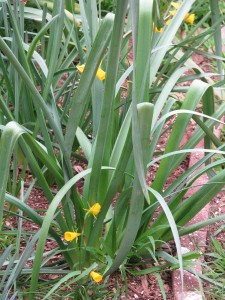 At the bottom of the bulb photo are Hoop Petticoats, and at the top, Little Witches, which I wrote about the other day. The little center unruffled hoops are so unique; besides Rip Van Winkle (which haven’t bloomed yet) these are my favorite.Also, Double Delight rose has bloomed. It is a double delight because its coloration is gorgeous and ranges from almost pure reddish pink to almost all white with some red on large, softly ruffled blooms. It also is extremely fragrant; my daughter said that it smelled the way rose water tastes, and that is perfectly true.Meringue Mushrooms coming up soon!
At the bottom of the bulb photo are Hoop Petticoats, and at the top, Little Witches, which I wrote about the other day. The little center unruffled hoops are so unique; besides Rip Van Winkle (which haven’t bloomed yet) these are my favorite.Also, Double Delight rose has bloomed. It is a double delight because its coloration is gorgeous and ranges from almost pure reddish pink to almost all white with some red on large, softly ruffled blooms. It also is extremely fragrant; my daughter said that it smelled the way rose water tastes, and that is perfectly true.Meringue Mushrooms coming up soon!
-
Hiking the Observatory Trail

- Pines on Palomar
For those of you who are waiting for an update about the permaculture garden, I’ll do that tomorrow or the next day. Many small things, although labor-intensive, have been happening, and some big things are happening tomorrow, so I should have good photos to share.Meanwhile, today was hiking day, and a gorgeous day it was. My hiking buddy Alex came up with an old magazine article about the Palomar Mountain Observatory Trail, which neither of us had heard about. You drive up to the gate that leads into the Palomar Observatory parking lot and look right… and there is the trailhead.

The Observatory closes this season at 3, and the parking lot at 3:45, so we parked on the street past the ‘no parking’ signs. (Disclaimer: These photos were taken with a lightweight cheapy digital camera which I use now when hiking instead of the big heavy camera, so the resolution isn’t superb.) To our surprise on this warm Spring day, there was still snow along the roadsides.

Snow Flower Alex made a Snow Flower instead of a Snow Angel. So artistic.
If you decide to hike this trail, at the sign there is a well-worn path to the left and a not-so-well-worn path to the right. We, of course, not taking Robert Frost’s advice, took the well-worn path, which led us into a maze of cut brush piles, fallen logs and criss-crossed paths. We laughed about survival skills just to get through the first five minutes of the trail. On our return we clearly saw the real pathway that was beautifully laid out, skirted the brush pile maze, and came around to the other side of the entrance sign. Of course. This trail is supposed to be 2.2 miles one way, and it travels downhill through mixed pine and oak forest, paralleling the roadway a lot of the time, until you reach the Observatory Campground. Then you have to hike uphill on the return. During the time of year that the campground is open (it isn’t now), you can park there and hike uphill first to the Observatory, take a tour and hike back down. Not all of the pathway is shaded, and it wasn’t a hard trail at all (if you didn’t get stuck in the brush piles!).

Woodpecker Tree If you are a birder, this is a wonderful area. I saw red shouldered hawks, nuthatch, spotted towhee, banded pidgeons and of course plenty of acorn woodpeckers. Woodpecker families ‘own’ trees. In the Fall when oak acorns drop, they compete with many other animals who eat the nuts for their high protein value. The acorn woodpeckers grab an acorn with their beak, fly up to the family tree, then nod and shake their heads slowly measuring the acorn up and down. Then clasping it in their feet they drill a hole exactly the size of the acorn. They jam that acorn in so that no one can get it out. They fill trees (and the sides of houses, too!) with acorns, and this is their pantry. Since acorns fall only once a year, this storehouse has to help feed the family for a year, with the addition of insects to their diet. During the year the woodpeckers will check on the acorns buried in the bark, and if the nuts have shrunk, they redrill a smaller hole for it. At this time of year and on into early summer you should be able to spot activity in tree cavities.
 What a wonderful thing it is to see later in the season little red and black heads peering out of their nest!
What a wonderful thing it is to see later in the season little red and black heads peering out of their nest!This area had been burned in the past, and the trees still show the burn marks.
 Many of the deciduous oaks are still bare, and there are stands of very old incense cedars,oaks and pines. The heavy smell of resin permiated the air, making me feel a little sleepy in the sunshine. What a fragrance! The terrain changes a lot, from shady forest, to streambed with a log crossing, to open areas bordered with manzanita just going into bloom.
Many of the deciduous oaks are still bare, and there are stands of very old incense cedars,oaks and pines. The heavy smell of resin permiated the air, making me feel a little sleepy in the sunshine. What a fragrance! The terrain changes a lot, from shady forest, to streambed with a log crossing, to open areas bordered with manzanita just going into bloom. Against the bluest of blue skies some of the white-barked bare trees made wonderful designs. A little more than two-thirds of the way down, you get to a platform jutting away from the trail, and from there is a view well worth the hike (if the beauty of the forest wasn’t enough). Down across the tree-studded mountain you can see the sweep of Mendenhall Valley, with brilliant green grazing land studded with cows and ponds.
Against the bluest of blue skies some of the white-barked bare trees made wonderful designs. A little more than two-thirds of the way down, you get to a platform jutting away from the trail, and from there is a view well worth the hike (if the beauty of the forest wasn’t enough). Down across the tree-studded mountain you can see the sweep of Mendenhall Valley, with brilliant green grazing land studded with cows and ponds.
Mendenhall ValleySnow We also passed an area where there had recently been a controlled burn to clear out the undergrowth. Then we’d dip down and cross a streambed with mossy rocks and deep, spongy loam.
Streambed 
- Along the pathways were boulders ranging from gigantic, mossy troll-like beasts, to well-constructed stone retaining walls.

Stone Wall 
Smaller Observatory From the path you can see the smaller of the two observatories glinting in the sun. How fortunate we are to live so close to such a famous research facility! You of course know that there are two roads up to the observatory because the first one switched back and forth too much for the truck to navigate that was hauling up the huge lens, so the second one is more straightforward. When traveling back down the mountain there are many scenic pull-outs. Take advantage of them, even if you’ve stopped many times before! The view down into Pauma Valley, and across the shapely mountains and hills that roll right out to the Pacific, is a reminder of how beautiful the land is and how lucky we are to live here.

Out to the Sea I apologize for the random craziness of the photos. I’m trying to insert them where I want after uploading them one at a time (whew!), and the program doesn’t agree with my placement. In fact, I just posted this and about four of the photos had disappeared, so I had to readjust. A work in progress!
